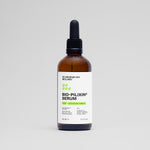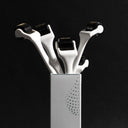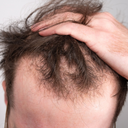Does testosterone cause hair loss? It's a question that crosses the minds of many, especially men noticing their hairlines creeping back or thinning.
While testosterone is often linked with strength and masculinity, it might also play a surprising role in hair loss.
In this article, we'll break down what science really says about testosterone, its relationship with hair loss, and whether you need to be concerned. Let's dive in and get to the root of it!
Table of content
Understanding the hair growth cycle and causes of hair loss

You probably don’t think much about how your hair grows, but it’s actually a fascinating and complex process. Hair growth happens in three distinct phases:
- Anagen (Growth phase): This is when new hair forms, lasting several years.
- Catagen (Transition phase): The active growth stops, and it lasts a few weeks.
- Telogen (Resting phase): Hair follicles rest, and this phase can last up to a year.
Shedding some hair daily is normal—around 50 to 200 strands. But if you’re losing more than that, it might signal an issue with your hair’s growth cycle. Several factors can interfere, such as:
- Poor nutrition
- Stress
- Medication reactions
- Tight hairstyles
While some causes are external, hormonal changes—especially involving testosterone—are also major players in hair loss.
External causes of hair loss
Everyday factors can sneak up on your hair health. Here are a few key culprits:
- Poor nutrition: Lack of vitamins like D, B-complex, iron, or zinc weakens hair and leads to shedding.
- Stress: Stress pushes hair into a resting phase, causing more shedding than usual, though it’s often temporary.
- Medication: Certain drugs, like those for blood pressure or depression, can mess with hair growth.
- Tight hairstyles: Constantly pulling your hair back tightly can cause permanent damage over time.
Hormonal causes of hair loss
Hormones play a huge role in hair loss, especially when testosterone and DHT are involved:
- Testosterone and DHT: DHT, a byproduct of testosterone, can shrink hair follicles, leading to thinning hair for those genetically prone.
- Menopause: For women, lower estrogen levels during menopause let testosterone take over, causing hair thinning.
- Thyroid issues: An underactive or overactive thyroid can disrupt hair growth and lead to more shedding.
As your leading source for hair health information over the past 4 years, we never compromise on accuracy. When it comes to your health, you deserve information you can truly rely on - and earning your trust is our top priority.
Here's how Scandinavian Biolabs ensures every piece of content meets the highest standards of accuracy and integrity:
- Credentialed Experts: Our reviewers are actively practicing doctors and medical researchers
- Stringent Reviews: Content undergoes rigorous editing by subject specialists and review by a practicing doctor.
- Evidence-Based: We rely on well-established research from trusted scientific sources like peer-reviewed journals and health authorities.
- Full Transparency: Our editorial standards, writer credentials, reviewer credentials, correction process, and funding are all publicly documented.
- Independent Voice: While we do promote products, we operate in a vacuum to business operations. Our main goal is just an unwavering commitment to providing medically-sound guidance.
You can count on Scandinavian Biolabs to consistently deliver the trustworthy health information you deserve. Read our Editorial Standards.
What is Dihydrotestosterone (DHT)?
DHT, or dihydrotestosterone, is a hormone that forms when testosterone converts into a more potent compound. It’s known to play a role in male pattern baldness by shrinking hair follicles, eventually leading to thinner hair or complete loss in some cases.
Does testosterone cause hair loss?
Yes, testosterone can indirectly cause hair loss by increasing levels of DHT, a hormone linked to male pattern baldness. Higher levels of testosterone lead to more DHT production, which in turn, binds to hair follicles and weakens them. However, the extent of hair loss depends on genetic factors. Those more sensitive to DHT are more likely to experience thinning or balding.
While testosterone itself doesn't directly cause hair loss, its conversion into DHT speeds up the process for individuals who are genetically predisposed. Testosterone might also encourage hair growth in other areas, like facial or body hair, even as scalp hair thins.
Does high testosterone cause hair loss?
High testosterone levels don’t directly cause hair loss, but they can lead to increased DHT production, which accelerates hair thinning in people who are genetically prone to male pattern baldness. It's not testosterone itself but the hormone DHT that’s the real culprit.
Does low testosterone cause hair loss?
No, low testosterone levels don’t typically cause hair loss on the scalp. While low testosterone can affect body and facial hair growth, there's no clear link between low T and male pattern baldness. Hair loss on the scalp is more related to a genetic sensitivity to DHT.
Does testosterone replacement cause hair loss?
Testosterone replacement therapy (TRT) doesn't directly cause hair loss or male pattern baldness. However, by increasing testosterone levels, TRT may also raise DHT levels, which can speed up hair thinning in those genetically prone to it. This side effect is something to discuss with a healthcare provider before starting treatment.
Does testosterone cause balding?
Testosterone itself doesn’t cause balding, but its byproduct, DHT, can trigger hair loss in people who are genetically predisposed to androgenetic alopecia. This condition occurs when hair follicles are sensitive to DHT, leading to their shrinkage and eventual dormancy.
Balding starts with thinning at the hairline, often forming an M-shape. Over time, the crown of the head may also thin, and these areas can merge, leaving just a U-shaped ring of hair around the sides of the head. The most significant risk factor isn’t high or low testosterone levels but a genetic sensitivity to DHT. If your hair follicles are highly sensitive to DHT, even normal levels can accelerate balding.
Read this: The 11 Best Hair Oils for Hair Growth: Proven Oils for Stronger, Healthier Hair
Does testosterone cause hair loss in females?

Yes, testosterone can contribute to hair loss in females, but it’s not the whole story. Women can experience female pattern baldness due to DHT’s effect on sensitive hair follicles, similar to how it affects men. However, instead of receding hairlines, women often experience thinning along the part, creating a "Christmas tree" shape.
While women generally have lower testosterone levels, hormonal imbalances that increase testosterone can lead to hair thinning. Genetics also play a major role in determining how sensitive a woman’s hair follicles are to DHT, which explains why some women are more prone to hair loss than others.
Does testosterone increase hair growth?
Yes, testosterone can increase hair growth in certain areas, particularly facial and body hair, but it can also lead to hair loss on the scalp by increasing DHT levels. So, while some may notice more body hair, scalp hair may thin if DHT levels rise.
The relationship between testosterone and hair growth is complex. High levels may promote growth in some areas while speeding up balding for those genetically predisposed to male pattern baldness.
Is hair loss from low testosterone reversible?
Hair loss from low testosterone can be treated, and in some cases, reversed. Medications like oral minoxidil and PRP injections are known to stimulate hair growth by prolonging the growth phase and thickening the hair follicles. Minoxidil works by increasing blood flow to the scalp, which nourishes and strengthens hair follicles, promoting new growth.
PRP injections, on the other hand, use your own plasma to stimulate hair growth. This method encourages the hair follicle to grow thicker and longer by delivering growth factors directly to the scalp. When combined with proper treatment, hair loss from hormonal imbalance can often be managed, if not reversed.
Do testosterone supplements cause hair loss?
Testosterone supplements don’t directly cause hair loss but can increase DHT levels, which may lead to hair thinning for those genetically predisposed to hair follicle sensitivity. In these cases, DHT binds to the follicles, weakening them over time and potentially accelerating balding.
While testosterone therapy can help with other symptoms like low energy or muscle loss, it’s worth discussing potential hair-related side effects with your doctor if you're at risk for male pattern baldness.
Read this: Does Shaving Increase Hair Growth? Here's Everything You Need to Know
How to prevent hair loss while taking testosterone
While taking testosterone doesn’t guarantee hair loss, it can accelerate the process for those genetically prone to male pattern baldness. Fortunately, there are several treatments and lifestyle choices that can help reduce the impact of hair thinning and keep your hair looking its best.
Finasteride
Finasteride is an FDA-approved medication commonly prescribed to combat androgenetic alopecia (AGA). It works by reducing the conversion of testosterone to DHT by about 70%.
This reduction in DHT can slow or even stop hair loss for many men. It’s typically taken as a 1mg daily pill and has been shown to be effective in preventing further hair loss, especially in those with a family history of balding.
Minoxidil
Minoxidil, known by the brand name Rogaine®, is another popular treatment option. Available as a foam or liquid solution, it promotes hair growth by shortening the resting phase and extending the growth phase.
While it's often used alongside finasteride, it may be particularly helpful for men with a receding hairline.
Low-level laser therapy (LLT)
LLT uses low-intensity light to stimulate cellular activity in hair follicles, promoting hair growth. Studies have shown that LLT can improve hair density and thickness in as little as 24 weeks.
Daily use with devices like helmet-style LLT treatments has been shown to boost hair health without the invasive nature of other treatments.
Hair transplant
For more severe hair loss, a hair transplant may be an option. If you have enough healthy hair on your scalp, a transplant can restore hair in thinning areas. Keep in mind, though, that this procedure can be costly and is generally not covered by insurance.
Lifestyle choices
While genetics play a large role, maintaining a healthy lifestyle can still support hair health. Eating a balanced diet rich in vitamins and managing stress can help your hair stay strong.
Be gentle with your hair and avoid harsh treatments like frequent dyeing or using high-heat styling tools.
A better approach for your overall hair health

For those looking to prevent hair thinning and promote growth without prescription medications, Bio-Pilixin® Serum offers a nature-inspired, drug-free solution.
Developed using stem cell technology, this serum is packed with plant growth factors that nourish and revitalize hair follicles, promoting healthier and thicker hair growth.
Bio-Pilixin® works by increasing blood flow to the scalp and delivering essential nutrients to hair follicles, stimulating growth.
It’s safe for daily use and has a satisfaction rate of 93% in clinical trials.
Most users notice a reduction in hair loss within the first few weeks of use, and significant results like improved hair density after around 150 days.
If you’re ready to see the difference for yourself, Bio-Pilixin® comes with a 150-day money-back guarantee.
Conclusion
Testosterone itself doesn’t directly cause hair loss, but the conversion of testosterone into DHT can accelerate hair thinning for those with a genetic sensitivity to this hormone.
While male and female pattern baldness share some common factors, like DHT’s role, the patterns of hair loss differ between genders.
Fortunately, there are several treatment options available, from medications like finasteride and minoxidil to low-level laser therapy and hair transplants.
Healthy lifestyle choices can also support overall hair health, even if they can't fully prevent genetic hair loss.
If you’re looking for a nature-inspired, drug-free approach to combat hair thinning, consider trying Bio-Pilixin® Serum. With its advanced plant growth factors and clinically proven results, this serum can help you regain healthier, fuller hair.
Plus, with a 150-day money-back guarantee, there's no risk in giving it a try!
FAQs
Will my hair grow back if I stop taking testosterone?
Hair regrowth is mostly irreversible after stopping testosterone hormone treatment. Even if you stop testosterone replacement therapy, hair loss caused by DHT is likely to persist, especially if you are genetically predisposed to male pattern baldness.
Does testosterone make hair thicker?
Yes, testosterone and other androgens like DHT can make hair thicker, especially in certain areas of the body. These hormones convert fine, lighter vellus hairs into thicker, darker terminal hairs in areas like the face and body.
Do bald men have more testosterone?
No, bald men don't necessarily have higher testosterone levels. Male pattern baldness is more related to higher levels of DHT and hair follicle sensitivity rather than overall testosterone levels. In fact, some balding men may have lower circulating testosterone levels.
Do hairy men have more testosterone?
Not always. While testosterone influences hair growth, having more body hair doesn’t necessarily mean someone has higher testosterone levels. Factors like genetics and hormone sensitivity also play a role in how hair grows.
Is high testosterone good?
While higher testosterone levels can increase muscle mass, it also comes with potential side effects such as acne, mood swings, and weight gain. More testosterone isn't always better, as it can cause imbalances and health issues.
References:






